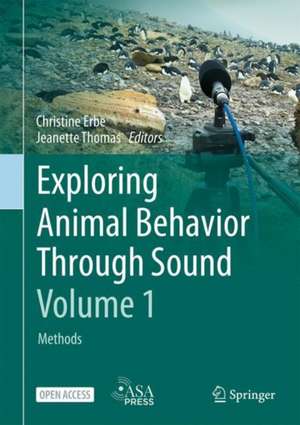Exploring Animal Behavior Through Sound: Volume 1: Methods
Editat de Christine Erbe, Jeanette A. Thomasen Limba Engleză Hardback – 4 oct 2022
Preț: 451.96 lei
Nou
Puncte Express: 678
Preț estimativ în valută:
86.48€ • 90.55$ • 71.73£
86.48€ • 90.55$ • 71.73£
Carte tipărită la comandă
Livrare economică 09-23 aprilie
Preluare comenzi: 021 569.72.76
Specificații
ISBN-13: 9783030975388
ISBN-10: 303097538X
Pagini: 517
Ilustrații: XVII, 517 p. 1 illus.
Dimensiuni: 178 x 254 mm
Greutate: 1.14 kg
Ediția:1st ed. 2022
Editura: Springer International Publishing
Colecția Springer
Locul publicării:Cham, Switzerland
ISBN-10: 303097538X
Pagini: 517
Ilustrații: XVII, 517 p. 1 illus.
Dimensiuni: 178 x 254 mm
Greutate: 1.14 kg
Ediția:1st ed. 2022
Editura: Springer International Publishing
Colecția Springer
Locul publicării:Cham, Switzerland
Cuprins
Introduction.- Advances in Bioacoustical Methods and Equipment.- Data collection methods.- Equipment Considerations.- Environmental effects on sound .- Source-path-receiver Model for airborne sounds.- Source-path-receiver Model for underwater sounds.- Sound Analysis Methods, Displays, Key acoustic terms.- Analysis Displays of animal sounds.- Statistical analysis and classification methods used in bioacoustical research.- Anatomical, behavioral, and physiological methods for audiometric studies on animals.- Effects of anthropogenic noise by taxa.- Future equipment, methods, and analysis in bioacoustics.- Glossary of Terms.
Recenzii
“The edited volume Exploring Animal Behavior through Sound is written by bioacoustics experts from across the globe ... . this volume is an extremely valuable resource for ecology students and researchers who want to add bioacoustics to their toolbox. It is also a very important and useful read for any researcher who works on protecting species and habitats.” (Oded Berger-Tal, The Quarterly Review of Biology, Vol. 98 (4), December, 2023)
Notă biografică
Christine Erbe holds an M.Sc. degree in Physics (University of Dortmund, Germany) and a Ph.D. in Geophysics (University of British Columbia, Canada). She worked as a Research Scientist at Fisheries and Oceans Canada, was Director of JASCO Applied Sciences Australia, and after a brief stint in high-school education, returned to academia as Director of the Centre for Marine Science and Technology at Curtin University (Perth, WA, Australia). Christine’s interests are underwater sound (biotic, abiotic, and anthropogenic), sound propagation, signal processing, and noise effects on marine fauna. She’s a John Curtin Distinguished Professor, Fellow of the Acoustical Society of America, former Chair of the Animal Bioacoustics Technical Committee of the Acoustical Society of America, and former Chair of the international conference series on The Effects of Noise on Aquatic Life.
Jeanette A. Thomas obtained her Ph.D. in Ecology and Evolutionary Biology from theUniversity of Minnesota (1979) on underwater vocalizations of Weddell seals in the Antarctic. She was Director of the Bioacoustics Laboratory at Hubbs-Sea World Research Institute (San Diego, CA, USA), a Senior Scientist at the Naval Ocean Systems Center (Kailua, HI, USA), and Professor in Biology at Western Illinois University (WIU; Macomb, IL, USA), where she helped established a Master’s degree program in Biology in collaboration with Shedd Aquarium (Chicago, IL, USA). In 2000, she developed the WIU Graduate Certificate in Zoo and Aquarium Studies. Jeanette received several awards through WIU: Distinguished Faculty Lecturer, Outstanding Researcher, and Distinguished Alumni. Jeanette was President of The Society for Marine Mammalogy (1994-1996) and Editor for Aquatic Mammals (2000-2009). Jeanette passed away unexpectedly on 16 July 2018.
Jeanette A. Thomas obtained her Ph.D. in Ecology and Evolutionary Biology from theUniversity of Minnesota (1979) on underwater vocalizations of Weddell seals in the Antarctic. She was Director of the Bioacoustics Laboratory at Hubbs-Sea World Research Institute (San Diego, CA, USA), a Senior Scientist at the Naval Ocean Systems Center (Kailua, HI, USA), and Professor in Biology at Western Illinois University (WIU; Macomb, IL, USA), where she helped established a Master’s degree program in Biology in collaboration with Shedd Aquarium (Chicago, IL, USA). In 2000, she developed the WIU Graduate Certificate in Zoo and Aquarium Studies. Jeanette received several awards through WIU: Distinguished Faculty Lecturer, Outstanding Researcher, and Distinguished Alumni. Jeanette was President of The Society for Marine Mammalogy (1994-1996) and Editor for Aquatic Mammals (2000-2009). Jeanette passed away unexpectedly on 16 July 2018.
Textul de pe ultima copertă
This open-access book empowers its readers to explore the acoustic world of animals. By listening to the sounds of nature, we can study animal behavior, distribution, and demographics; their habitat characteristics and needs; and the effects of noise. Sound recording is an efficient and affordable tool, independent of daylight and weather; and recorders may be left in place for many months at a time, continuously collecting data on animals and their environment. This book builds the skills and knowledge necessary to collect and interpret acoustic data from terrestrial and marine environments. Beginning with a history of sound recording, the chapters provide an overview of off-the-shelf recording equipment and analysis tools (including automated signal detectors and statistical methods); audiometric methods; acoustic terminology, quantities, and units; sound propagation in air and under water; soundscapes of terrestrial and marine habitats; animal acoustic and vibrational communication; echolocation; and the effects of noise. This book will be useful to students and researchers of animal ecology who wish to add acoustics to their toolbox, as well as to environmental managers in industry and government.
Caracteristici
This book is open access, which means that you have free and unlimited access Introduces standard terminology, procedures, equipment, and analysis tools for animal bioacoustic studies Unravels complex concepts, such as sound propagation and discusses common pit-falls Points to numerous resources (in print and online) for further in-depth reading
